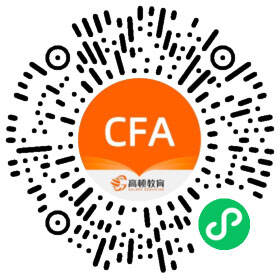





1、凡本网站注明“来源高顿教育”或“来源高顿网校”或“来源高顿”,的所有作品,均为本网站合法拥有版权的作品,未经本网站授权,任何媒体、网站、个人不得转载、链接、转帖或以其他方式使用。
2、经本网站合法授权的,应在授权范围内使用,且使用时必须注明“来源高顿网校”或“来源高顿”,并不得对作品中出现的“高顿”字样进行删减、替换等。违反上述声明者,本网站将依法追究其法律责任。
3、本网站的部分资料转载自互联网,均尽力标明作者和出处。本网站转载的目的在于传递更多信息,并不意味着赞同其观点或证实其描述,本网站不对其真实性负责。
4、如您认为本网站刊载作品涉及版权等问题,请与本网站联系(邮箱fawu@gaodun.com,电话:021-31587497),本网站核实确认后会尽快予以处理。
2024年上半年CFA考试早鸟报名通道已经结束,尚未报名的同学可以报名参加2024年8月CFA考试的早鸟阶段。CFA报名条件要求并不高,感兴趣的小伙伴可以了解一...
2023-12-052024年8月CFA报考安排已发布,根据CFA报名简章要求,考试窗口为:CFA一级、CFA二级、CFA三级。准备报名的考生问:江苏省2024年8月CFA考试报名条件都有什么?...
2023-12-052023年11月CFA考试成绩时间已经公布!对于CFA考试成绩查询考生可登录CFA协会进行查看,具体查询入口也已经确定,对此小编在线就为考生详细整理归纳一下...
2023-12-05CFA2024考试安排一览!注意!目前2024年CFA考试时间已经公布,请同学们进入CFA协会官网查询。如同学们想要报考,请在各考季规定的报名时间内提交报考信...
2023-12-042024年CFA证书对就业指导有哪些帮助呢,最近有小伙伴咨询到学姐这个问题,今天小编就来详细的为大家进行解答,下面请跟随学姐一起来看看吧~ ...
2023-12-042024年8月广东CFA考试报名时间在几号进行?广东2024年CFA考试报名时间已经公布,报名时间为2023年11月14日至2024年5月14日,考生们可以作为参考,提前准备考...
2023-12-04安徽省2024年8月CFA报名时间在什么时候进行?2024年8月CFA报名简章已发布,早鸟报名时间为2023年11月14日至2024年1月23日,报名相关手续流程小编已汇总至下文...
2023-12-042024年CFA励志助学奖学金-Access Scholarship怎么申请?最近有小伙伴咨询到学姐这个问题,今天小编就来详细的为大家进行解答,下面请跟随学姐一起来看看吧...
2023-12-0424年8月CFA考试时间定了!对于准备参加考试的考生来说,目前最关注的就是CFA考试时间,24年8月CFA考试时间已经公布,接下来小编在线就为各位考生进行一...
2023-12-042024年2月CFA考试在即,请同学们仔细阅读考前注意事项。另外,强烈建议考生携带考试确认信,CFA考试允许携带的计算器。具体内容如下:...
2023-12-04老师 为什么第二题不做处理呢 不应该计入资本公积—股本溢价吗
老师好,这道题的会计分录应该是这样的吧,但是我不理解其他综合收益2000那个步骤,他不是以摊余成本计量的金融资产已确认损失2000万吗?不应该是信用减值损失的科目吗?为什么写其他综合收益这个科目在这里?
老师您好,固定资产清理,卖掉时候,转银行存款和资产处置损益,差别在哪里呢。我觉得卖掉固定资产,转哪个都差不多啊,谢谢老师。
选项c,资本公积—股本溢价4500为什么不选?
收回前期已核销的坏账,坏账准备记录在贷方怎么理解
老师 为什么第二题不做处理呢 不应该计入资本公积—股本溢价吗
老师好,这道题的会计分录应该是这样的吧,但是我不理解其他综合收益2000那个步骤,他不是以摊余成本计量的金融资产已确认损失2000万吗?不应该是信用减值损失的科目吗?为什么写其他综合收益这个科目在这里?
老师您好,固定资产清理,卖掉时候,转银行存款和资产处置损益,差别在哪里呢。我觉得卖掉固定资产,转哪个都差不多啊,谢谢老师。
选项c,资本公积—股本溢价4500为什么不选?
收回前期已核销的坏账,坏账准备记录在贷方怎么理解
山东省CFA报名时间2024年8月安排在哪天?目前,备考2024年CFA考试的同学们,都比较关心24年8月报名时间在什么时候?2024年8月山东省CFA早鸟报名时间已经开始,请大家注意时间!详情内容请看下文!...
2023-12-06CFA注册费和报名费区别是什么?都多少钱?CFA注册费是初次报名考试的考生需缴纳,如果是补考或者报名CFA二级、三级考试,则无需重复支付注册费用。2024年CFA报名费用详见正文。...
2023-12-05CFA考试成绩查询入口具体官网!CFA考试中考生们最关注的就是成绩查询入口,目前cfa考试成绩即将公布,考生们抓紧时间查询吧,那么对于CFA成绩查询入口,下面就由小编在线就为各位考生进行一下详细的整理。...
2023-12-052023年11月份CFA成绩查询时间已发布,考生速查!根据考试级别的不同,成绩预计在考试窗口结束后约5-8周发布。小编建议考生不要着急,尽量错峰查询,避免造成拥堵,同时也要调整自己的心态,无论成绩如何,我们都要正确面对。...
2023-12-052024年上半年CFA考试早鸟报名通道已经结束,尚未报名的同学可以报名参加2024年8月CFA考试的早鸟阶段。CFA报名条件要求并不高,感兴趣的小伙伴可以了解一下,下面小编为大家整理了详细内容,一起来看看吧。...
2023-12-052024年2月CFA考试于2月15日开考,为了帮助各位考生顺利参加考试,本文整理了cfa考试考前、考中、考后的注意事项,希望各位考生仔细阅读本文,祝愿大家取得理想成绩!...
2023-11-292024年2月CFA考试时间是2月15日-2月25日,考生请在规定的准考信打印时间期限内完成准考信打印的相关工作。小编整理CFA准考信打印流程,简单明晰,希望能够对考生打印准考信有所帮助。...
2023-11-292023年8月CFA考试通过率大概有多少?根据CFA协会官方公布的数据为CFA一级:37%、CFA二级:44%、CFA三级:47%。是否能通过CFA考试需要根据考生自己掌握知识的情况以及临场发挥的状态而定,请大家放心备考。...
2023-11-29速看!CFA考试通过率大概多少?2024年CFA考试公告已经发布,对此CFA考试通过率想必初次参加考试的考生都不是特别了解,下面小编就为考生们详细整理归纳一下,快来看看吧。...
2023-11-29众所周知,cfa考试难度大,报一个培训班有助于提升自己的学习效率。那么,广州CFA网课机构哪个好?对考生有什么好处?相信看过下文你就会明白了。...
2023-11-28广州CFA培训哪个网校好?在备考金融分析师(CFA)考试的过程中,很多考生会选择参加培训机构的课程以提高备考效率和准确性。今天小编就为大家详细介绍一下!...
2023-11-28